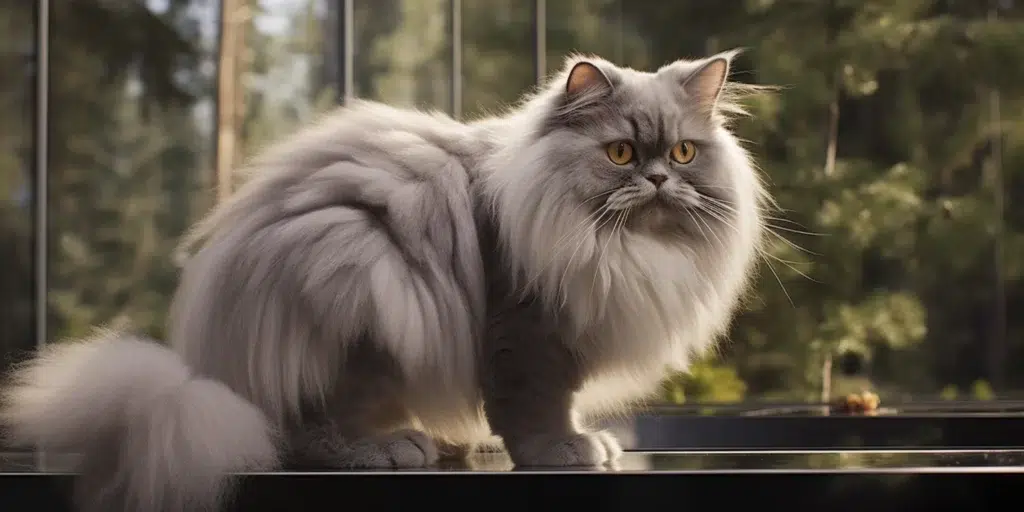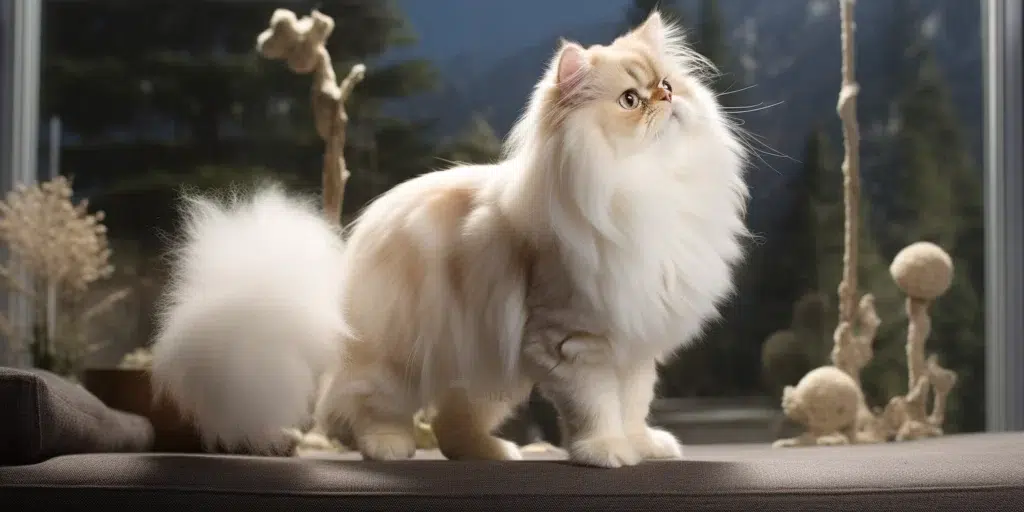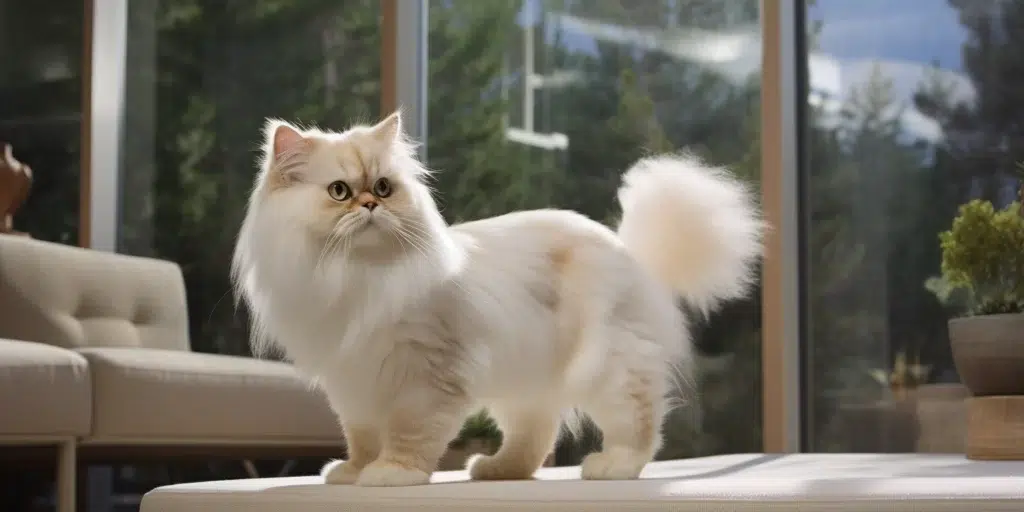If you are looking for a pet cat that is both beautiful and intelligent, the Persian cat could be exactly what you need! With its stunningly long and luxurious coat of many colors, expressive eyes, and short yet sturdy body, this breed will look right at home in any environment.
These cats love to communicate with their owners; they will often look at them incredulously when they don’t understand something or want something from them. On top of all that, Persians are also very easy to train.
Whether you are new to Persian cats or a seasoned pro, it is important to provide your furry friend with the proper care and nutrition they need for a long and healthy life. So let’s begin!
Breed Overview

The Persian cat is an elegant and beautiful breed that has captured the hearts of many fans around the world. Its silky fur and sweet disposition make it a popular choice for people looking for a loving companion.
The breed has its roots in Mesopotamia, now modern-day Iran, where its long hair was likely the result of a natural mutation. In 1626, Italian nobleman Pietro Della Valle brought some of these longhaired cats to Europe and they eventually became known as “Asiatic” cats due to their origin.
By the 19th century when breeding and cat shows became more popular, fanciers began selectively breeding Persian cats for round heads and flat faces. All features which have made this breed so beloved today.
The Persian made its way to America during the late 19th century where it quickly became one of the most sought-after by pet owners. It also became popular among those keeping cats for show purposes.
Today Persians are still widely regarded as one of the top contenders in the cat world. Many people either at home or at cat shows adore this breed and show their love to them.
Their unique temperament and beautiful appearance combined with good health make them ideal house pets suitable for any lifestyle.
Overall it’s easy to see why this charming creature continues to be such an admired part of our lives. Having gone through centuries worth of changes while maintaining beauty throughout each era – providing us nothing but love and joy!
Related: Asian Cat Breeds with Captivating Histories and Origins
Identifying Persian Cat
The Persian cat is a unique breed that stands out among other cats. The most striking feature of the Persian is its luxurious, long coat that flows to the floor with a thick ruff around the head.
With its massive musculature and well-developed body, this powerful package has a head as round as a ball and large copper eyes that light up its face. Its sweet expression is enhanced by an equally round chin and snub nose which sits just between them in perfect balance.
Persian cats come in a wide variety of stunning colors. From classic white to rich chocolate, they can be found in nearly every hue imaginable. Some of the most popular coat colors include red, cream, black, blue, lilac, and silver.

For those looking for something truly unique, there is also the tortoiseshell Persian cat which combines shades of black or brown with orange or yellow.
There are also bicolor Persian cats that combine two different shades like white and red; and tricolor which has three distinct hues such as black with red & white patches.
There is even a rarer variation called the smoke Persian cat which has an even mix of light & dark fur all over its body. This breed of Persian cats was almost extinct in the 1940s but there are still a few left.
No matter what color you choose you can rest assured your Persian cat will be sure to turn heads!
Personality Traits
The Persian cat is characterized by its gentle, sweet nature which makes it a great fit in any household. Their calm presence brings a sense of peace and relaxation to their home.
They tend to be creatures of habit who take comfort in staying within the same routine day after day. When they are comfortable with their environment they will show you this through their expressive eyes and soft purrs.
Persian cats are not high-energy cats and mostly enjoy lounging around on the ground or draping over your lap for petting sessions. However, when given the chance, these loving cats do enjoy playing with toys or running around after teasers that keep them entertained for hours on end.
When it comes to interacting with people, Persians can be quite shy at first but will eventually warm up to those who handle them gently and patiently. Children should always be taught how to properly interact with these sensitive felines as too much noise or roughness could scare them away easily!
These cats thrive off of love but also understand personal space so while they may not demand your undivided attention all the time, they thoroughly appreciate it when you’re ready to give some back!
They are known to have a calm and reserved demeanor, so they won’t get too over-excited when interacting with children. Unlike some other more active breeds, Persians don’t require much exercise or stimulation, making them easy for kids to handle without any risk of them running away or becoming overly energetic.
Persian cats are also very accepting of other pets who don’t chase them around or otherwise cause them anxiety. With their naturally placid nature, Persians often take on a submissive role when other pets are available.
Activity Level
Persians are known for their placid and calm demeanors, but they also have bursts of kitten-like activity at times. When they are feeling energized, Persians will run around the room and play with interactive toys.
It is important to ensure that your Persian gets regular exercise daily to keep them healthy and happy. But don’t force it on them as they might not like it.
The best way to make sure your cat stays active is to provide plenty of stimulating toys like balls or catnip mice for them to chase after. Your Persian might not be the most outgoing cat when it comes to physical activity, so you may need to encourage them by playing along with them every once in a while.
Persians also enjoy lounging around and being close to their owners. They will often stay around you or snuggle up in your bed at night time.
No matter what atmosphere they find themselves in though, Persians tend to remain friendly towards everyone and do not mind changes much either!

Persian Cat Loyalty
Persian cats are known for their devotion to their family and will always be there when you need them. They provide security and comfort in times of distress and have a natural ability to sense when their owners need cheering up.
Persian cats are incredibly loyal, they love spending time with their owners and enjoy snuggling up on the sofa or following them around the house. Their loyalty is often rewarded with lots of attention, cuddles, head rubs, playtime, and treats!
Persian cats tend to be very relaxed around their humans so it’s easy for them to form strong bonds with anyone who shows kindness and affection towards them. This makes Persians an ideal pet if you’re looking for a companion who will always be by your side no matter what life throws at you.
Love Of Water
Persian cats are NOT known for their love of water. They often detest it and can become quite distressed when exposed to the liquid. This is why it’s important to always keep them calm when in contact with water, using lukewarm temperatures that won’t shock them.
Despite this, there are still some ways to make Persian cats more comfortable around water. Keeping a shallow bowl or container filled with fresh water can help as they may be curious enough to dip their paws into it.
Introducing activities such as playing fetch in a kiddie pool or spraying them lightly with a garden hose can help desensitize them over time so that they don’t panic whenever coming into contact with the liquid.
With patience and plenty of positive reinforcement, Persian cats may eventually learn to enjoy the sensation of water on their fur coats and have fun at bath time!
Trainability
Persian cats, due to their gentle and docile nature, can be difficult to train. They are not as eager to learn new things or tricks as other cats, such as Siamese or Bengal breeds.
Therefore, it often takes more patience and consistency when training a Persian cat than with some of the more active cat breeds.
Training should start early for it to be effective and successful; this also helps build a strong bond between pet and owner from the very beginning.
Despite the challenges that come with training a Persian cat, they are still very loyal companions who will respond positively if given enough time and effort during the training process.
With patience, reward-based techniques or interactive toys can help teach basic commands while strengthening your relationship with your feline.

Adult Size
Persians have a medium-sized build but look much bigger due to their thick and long fur. The average height for an adult Persian cat is between 8 – 10 inches (20-25 cm) at the shoulder and can weigh between 7-12 lbs (3-5 kg). Keep in mind that male and female Persian cats have slight differences.
They come in both short hair and long hair varieties, with the long hair having fur that can reach up to 6 inches (15 cm) in length. Their coats are usually very dense and plush, which helps keep them warm during cold winter months.
The length of a Persian cat’s body typically ranges from 14 to 18 inches (35–45 cm), making it one of the longest domesticated cats available. This extra length gives Persians ample room to lounge around without being cramped or uncomfortable.
The growth rate of Persian cats varies greatly depending on their age and life stage. As kittens, they grow quickly – reaching their full size by the time they are 10 months old.
During this period, they gain around 200 to 300 grams per month. After that, their growth slows down significantly as an adult cat.
After the first year, on average, a Persian cat will only gain 1 to 2 pounds every year until it reaches its mature size, which is usually between 6 and 12 pounds for a fully grown adult cat.

Life Expectancy
The Persian cat is a long-lived breed, with an average lifespan of 12 – 17 years. This gives their owners plenty of time to enjoy their beautiful and affectionate personalities. To ensure your Persian cat reaches its maximum life expectancy, there are several steps you can take to keep it in good health.
First, provide your cat with regular veterinary checkups and preventive care such as vaccinations. Make sure that all necessary treatments are performed on schedule, including dental care and parasite control like deworming or flea prevention medication.
Second, feed your Persian a high-quality diet designed for cats at their particular life stage (kitten/adult/senior). A balanced diet rich in proteins and fatty acids helps maintain healthy skin and coat as well as overall physical condition.
Lastly, give your Persian plenty of exercise – indoor playtime activities such as chasing toys or bird watching provide mental stimulation while helping them stay physically active too!
With proper nutrition, veterinary care, and daily exercise your beloved feline companion should live a long happy life full of love and laughter!
Persian Cat Care
Caring for a Persian cat requires daily attention and dedication. From their long, luxurious coats to the need for regular bathing, these cats need a lot of care and attention. The first step in caring for your Persian is to brush them every day.
Their thick fur can become matted if not brushed regularly, so you must use the correct type of comb or brush to ensure that mats don’t form. It is also recommended that you bathe your cat once a month to keep its coat clean and free from dirt and debris.
The litter box is another area you should pay special attention to when caring for your Persian cat. Litter can get stuck in their paws or coat, which may lead them to stop using the box altogether.
Excessive tearing is another issue with Persian Cats so make sure you wipe away any build-up around their eyes daily with a damp cloth or soft tissue paper. You should also pay attention to their nails and their dental hygiene. Regularly brush their teeth to ensure a healthy Persian.
It’s best to keep your Persian as an indoor-only pet since they are not built for outdoor life and could easily get injured by other animals or exposed to dangerous elements like extreme temperatures or toxins outside.
Keeping them indoors will also help reduce grooming time as they won’t have access to dirt and leaves which might otherwise stick on their fur while outdoors!

Diet
For Persian cats, a high-quality diet is essential for their health and well-being. Proper protein and nutrient intake are especially important as these cats have a greater tendency to become overweight after they are altered (spayed/neutered).
You should pay attention to the quality of the food you are providing your cat with as well as the quantity. It’s recommended to feed a Persian cat wet food or canned food that contains animal proteins like fish, chicken, or beef.
Dry foods should be avoided since they tend to be low in moisture and higher in carbohydrates which can lead to weight gain. However, it’s best if you consult with a veterinarian before switching their pet’s diet completely.
It’s also important for owners to provide plenty of fresh water daily for hydration purposes – this will help keep your pet healthy and avoid dehydration during hot weather months when temperatures can rise quickly outside.
In addition, adding cat supplements may help promote healthy skin and coat condition in Persians since this breed tends towards having longer hair coats than other breeds. This can often cause matting if not regularly maintained or brushed out.
When feeding your cat, portion controlling is key — it’s easy to slip up on meal sizes but doing so could result in them becoming obese due to overeating! Make sure you always measure out the proper amount of food per day according to what your vet recommends based on your pet’s age and activity level.
This will ensure optimal nutrition without any unhealthy weight gain occurring over time!
Exercise Requirement
Keeping Persian cats active and playing is important to their overall health and well-being. Not only does it provide physical exercise, but it also helps stimulate their minds and keeps them from becoming bored.
Exercise can help prevent obesity, which is a common problem in Persians due to their sedentary nature. Interactive toys can help keep your cat’s mind sharp by encouraging problem-solving skills and helping to reduce stress levels.
Playtime with your cat is also important as it helps build the bond between you two. Playing together provides an outlet for positive reinforcement of good behavior too!
By providing interactive toys such as scratching posts or balls with bells inside, your cat will have plenty of things to explore and interact with throughout the day. This can lead to more contentment overall.
Shedding Levels
In the early stages of a Persian cat’s life, it will shed moderately and may require minimal grooming. As they reach adulthood, however, their shedding intensifies substantially as they prepare to change their coats twice a year.
During this time, you should groom your Persian cat more frequently to help remove dead fur and prevent matting. This is especially important since the thicker coat of Persians makes them more prone to hairballs than other breeds.
Brushing your cat’s coat daily during shedding season can also help them look neat and reduce excess fur in your home. However, once the shedding cycle finishes, you may find that grooming once or twice a week is enough to keep their coats looking healthy.
In addition to regular brushing, it’s also important to give them regular baths, usually about every two weeks. This is so that their skin and fur remain clean and healthy.
Following these simple steps will ensure your beloved feline looks beautiful all year round! it will also help you control allergies if you have allergy to your Persian cat.
Health Issues
Persian cats are generally healthy, but they can be prone to certain diseases and health conditions. The most common diseases for this breed include polycystic kidney disease (PKD), respiratory problems, eye problems such as progressive retinal atrophy (PRA), and hypertrophic cardiomyopathy.
Owners should work with their breeder and veterinarian to ensure their cat has been checked for these issues. Persian cats can also be at risk for obesity due to their sedentary lifestyle, so you should make sure that they get plenty of exercise opportunities and a balanced diet to keep your cat healthy.
A poor diet and living conditions can have a severe impact on the health of a Persian cat. Without proper nutrition, cats are prone to obesity and other dietary-related issues such as diabetes, kidney disease, and digestive problems.
Living in an unclean environment can also lead to infections or parasites that could cause serious health problems.
To prevent these diseases it is important to provide your Persian cat with a balanced diet high in protein and low in carbohydrates, along with plenty of fresh water daily.
Additionally, keep their living space clean by cleaning litter boxes regularly and providing comfortable bedding for them to sleep on.
Buying Tips
- Research the breed: Before you buy a Persian Cat, it is important to research the breed and make sure this is the right type of cat for you. Persian Cats are known for their long coats and sweet personalities, but they also require regular grooming and may need extra attention when it comes to health concerns like breathing issues because of their flat faces.
- Find a reputable breeder: It’s important to find a breeder who has experience with this particular breed, so take your time researching different breeders in your area or online until you find one that meets all of your needs. Be sure to ask questions about the parents’ health history as well as any genetic testing they have done on their cats.
- Look at personality traits: Once you’ve chosen a reputable breeder, be sure to look into each kitten’s personality traits before making your final decision about which one you want to bring home with you! Pay attention not only to how active they are but also to how affectionate and socialized they seem—these factors will help determine if this particular cat will fit in well with your family dynamic and lifestyle.
- Ask about vaccinations: Before bringing home any new pet (especially kittens!), make sure that all necessary vaccinations have been administered by the breeder or veterinarian beforehand—this can help protect both yourself and your new pet from potential illnesses down the line!
Related: Amazing Persian Cat Names & How To Select One!

Conclusion
The Persian Cat is a breed of cat with distinct features that make it one of the most popular cats in the world. They are known for their luxurious long coats, gentle personalities, and striking facial features.
With proper care and attention to their grooming needs, they can be an ideal addition to any home. Persian Cats are great companions and make wonderful family pets as they are incredibly intelligent, affectionate, and loyal.
If you’re looking for a pet that will provide years of love and companionship, then a Persian Cat might be just what you’re looking for!